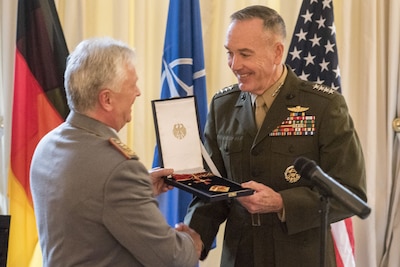By Jim Garamone DoD News, Defense Media Activity
BRUSSELS, Jan. 15, 2018 — It takes only a look at Russia’s
recent history and military investments to understand that the nation is a
threat to Europe and beyond, the chairman of the Joint Chiefs of Staff said
here today.
Marine Corps Gen. Joe Dunford is participating in the NATO
Military Committee meeting at the alliance headquarters here tomorrow.
A resurgent Russia is the greatest threat on the continent,
and the alliance is putting in place capabilities to deter the Eastern
neighbor, Dunford said. Russia has modernized many aspects of its military,
including redesigning and modernizing its nuclear capability, modernizing its
maritime capabilities, developing new cyber and electronic warfare capabilities
and fielding antispace capabilities. The alliance has been on the path to
addressing the Russian modernization program, he added.
And Russia will use its capabilities, he noted. “You’ve got
to look at behavior, so you’ve got to go back and look at Georgia and look at
Ukraine,” the chairman said.
Russian Actions in Georgia and Ukraine
In 2008, about 79,000 Russian soldiers marched into the
Georgian provinces of South Ossetia and Abkhasia. They faced roughly 10,000
Georgian soldiers, who were forced to retreat. Russia continues to occupy the
provinces.
In Ukraine, Russia illegally annexed Crimea from the nation
in 2014 and have integrated the province into the Russian Federation. The
Russians used unmarked tanks and soldiers without identifying marks on their
uniforms to move into the region. Russian troops pushed further west in the
Donets region of Ukraine, and fighting continues in that region. The United
States and the rest of NATO is helping train Ukrainian troops to defend their
sovereignty.
Nations have a right of nations to defend themselves and not
be attacked by others, Dunford said. This is true, he added, whether they march
into a nation in uniform or the attack “is a combination of unconventional
operations, information operations, cyber, economic coercion, and political
influence.”
“It is still a violation of sovereignty,” the chairman said.
NATO’s Response
Russia’s annexation of Crimea and further actions in Ukraine
got NATO’s attention. The alliance first moved to assure all allies with
enhanced forward presence, stationing four multinational battlegroups in
Estonia, Latvia, Lithuania and Poland. The United States led the battlegroup in
Poland, and further built up forces in Europe with the addition of a rotational
brigade-sized element and an aviation brigade. Today, the focus is on
increasing alliance deterrence capabilities for European security.
The path in Europe is consistent with the National Security
Strategy in regards to Russia, the general said.
“When we think about Russia, we think about their actions
over the past few years, and then when we look at the last decade of
investments the Russians have made,” Dunford said. “There is not a single
aspect of the Russian armed forces that has not received some degree of
modernization over the past decade.” All this, he added, informs his assessment
of Russia.
Since the alliance’s Warsaw Summit in 2016, the NATO chiefs
of defense have been examining initiatives taken by NATO’s supreme allied
commander for Europe, U.S. Army Gen. Curtis M. Scaparrotti, to make sure NATO
command structure and NATO forces fit the purpose.
“I would say that none of us are comfortable with where we
are,” Dunford said. “If you are complacent in this business, you are obsolete.
So you need to stay focused.”
Organization and Modernization
The initiatives look at alliance organization and specific
capability areas where modernization is most urgently needed. “I would
highlight the maritime domain, rear-area operations, organizing land forces in
context of NATO contingencies,” Dunford said. “In terms of capabilities: cyber,
information warfare and missile defense.”
For U.S. troops, the rotational brigade plan will continue
as DoD studies other models. The current thinking in the department is the
rotational model builds readiness in the force. “Our soldiers go through the
process of deploying, training exercising for nine months and then coming back
home,” Dunford said.
While in Europe, the forces are singly focused on all their
tasks. “This model seems to work pretty well for the soldiers, for the families
and allows us to meet commitments with the infrastructure available,” the
chairman said. “It won’t surprise you, I have a bias toward rotational models.
I spent my career in a service that has used the rotational model to meet our
commitments.”
The general said the feedback from the chiefs and the
soldiers on the ground is good, but the department is open to studying other
methods of basing.







